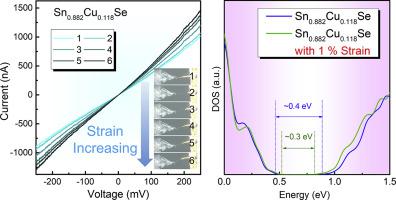当前位置:
X-MOL 学术
›
Mater. Today Phys.
›
论文详情
Our official English website, www.x-mol.net, welcomes your
feedback! (Note: you will need to create a separate account there.)
A Synergy of Strain Loading and Laser Radiation in Determining the High-Performing Electrical Transports in the Single Cu-Doped SnSe Microbelt
Materials Today Physics ( IF 10.0 ) Pub Date : 2020-06-01 , DOI: 10.1016/j.mtphys.2020.100198 Y. Zheng , X.-L. Shi , H. Yuan , S. Lu , X. Qu , W.-D. Liu , L. Wang , K. Zheng , J. Zou , Z.-G. Chen
Materials Today Physics ( IF 10.0 ) Pub Date : 2020-06-01 , DOI: 10.1016/j.mtphys.2020.100198 Y. Zheng , X.-L. Shi , H. Yuan , S. Lu , X. Qu , W.-D. Liu , L. Wang , K. Zheng , J. Zou , Z.-G. Chen

|
Semiconducting microbelts are key components of the thermoelectric micro-devices, and their electrical transport properties play significant roles in determining the thermoelectric performance. Here, we report heavily Cu-doped single-crystal SnSe microbelts as potential candidates employed in thermoelectric micro-devices, fabricated by a facile solvothermal route. The considerable Cu-doping concentration of ~11.8 % up to the solubility contributes to a high electrical conductivity of ~416.6 S m-1 at room temperature, improved by one order of magnitude compared with pure SnSe (38.0 S m-1). Meanwhile, after loading ~1 % compressive strain and laser radiation, the electrical conductivity can be further improved to ~601.9 S m-1 and ~589.2 S m-1, respectively, indicating great potentials for applying to thermoelectric micro-devices. Comprehensive structural and compositional characterizations indicate that the Cu+ doping state provides more hole carriers into the system, contributing to the outstanding electrical conductivity. Calculations based on first-principle density functional theory reveal that the heavily doped Cu lowers the Fermi level down into the valence bands, generating holes, and the 1 % strain can further reduce the bandgap, strengthening the ability to release holes, and, in turn, leading to such an excellent electrical transport performance. This study fills the gaps of finding novel materials as potential candidates employed in the thermoelectric micro-devices and provides new ideas for micro/nanoscale thermoelectric material design.
中文翻译:

应变加载和激光辐射在确定单铜掺杂 SnSe 微带中的高性能电传输中的协同作用
半导体微带是热电微器件的关键组成部分,其电传输特性在决定热电性能方面起着重要作用。在这里,我们报告了重掺杂 Cu 的单晶 SnSe 微带作为热电微器件中采用的潜在候选物,通过简便的溶剂热途径制造。高达 ~11.8% 的相当大的 Cu 掺杂浓度有助于在室温下实现 ~416.6 S m-1 的高电导率,与纯 SnSe (38.0 S m-1) 相比提高了一个数量级。同时,在加载~1%的压缩应变和激光辐射后,电导率可以进一步提高到~601.9 S m-1和~589.2 S m-1,表明在热电微器件中具有巨大的应用潜力。全面的结构和成分表征表明,Cu+ 掺杂状态为系统提供了更多的空穴载流子,有助于出色的导电性。基于第一性原理密度泛函理论的计算表明,重掺杂的 Cu 将费米能级降低到价带中,产生空穴,1% 的应变可以进一步减小带隙,增强释放空穴的能力,反过来,导致如此出色的电气传输性能。该研究填补了寻找新材料作为热电微器件潜在候选材料的空白,并为微/纳米级热电材料设计提供了新思路。有助于出色的导电性。基于第一性原理密度泛函理论的计算表明,重掺杂的 Cu 将费米能级降低到价带中,产生空穴,1% 的应变可以进一步减小带隙,增强释放空穴的能力,反过来,导致如此出色的电气传输性能。该研究填补了寻找新材料作为热电微器件潜在候选材料的空白,并为微/纳米级热电材料设计提供了新思路。有助于出色的导电性。基于第一性原理密度泛函理论的计算表明,重掺杂的 Cu 将费米能级降低到价带中,产生空穴,1% 的应变可以进一步减小带隙,增强释放空穴的能力,反过来,导致如此出色的电气传输性能。该研究填补了寻找新材料作为热电微器件潜在候选材料的空白,并为微/纳米级热电材料设计提供了新思路。1%的应变可以进一步减小带隙,增强释放空穴的能力,进而导致如此出色的电传输性能。该研究填补了寻找新材料作为热电微器件潜在候选材料的空白,并为微/纳米级热电材料设计提供了新思路。1%的应变可以进一步减小带隙,增强释放空穴的能力,进而导致如此出色的电传输性能。该研究填补了寻找新材料作为热电微器件潜在候选材料的空白,并为微/纳米级热电材料设计提供了新思路。
更新日期:2020-06-01
中文翻译:

应变加载和激光辐射在确定单铜掺杂 SnSe 微带中的高性能电传输中的协同作用
半导体微带是热电微器件的关键组成部分,其电传输特性在决定热电性能方面起着重要作用。在这里,我们报告了重掺杂 Cu 的单晶 SnSe 微带作为热电微器件中采用的潜在候选物,通过简便的溶剂热途径制造。高达 ~11.8% 的相当大的 Cu 掺杂浓度有助于在室温下实现 ~416.6 S m-1 的高电导率,与纯 SnSe (38.0 S m-1) 相比提高了一个数量级。同时,在加载~1%的压缩应变和激光辐射后,电导率可以进一步提高到~601.9 S m-1和~589.2 S m-1,表明在热电微器件中具有巨大的应用潜力。全面的结构和成分表征表明,Cu+ 掺杂状态为系统提供了更多的空穴载流子,有助于出色的导电性。基于第一性原理密度泛函理论的计算表明,重掺杂的 Cu 将费米能级降低到价带中,产生空穴,1% 的应变可以进一步减小带隙,增强释放空穴的能力,反过来,导致如此出色的电气传输性能。该研究填补了寻找新材料作为热电微器件潜在候选材料的空白,并为微/纳米级热电材料设计提供了新思路。有助于出色的导电性。基于第一性原理密度泛函理论的计算表明,重掺杂的 Cu 将费米能级降低到价带中,产生空穴,1% 的应变可以进一步减小带隙,增强释放空穴的能力,反过来,导致如此出色的电气传输性能。该研究填补了寻找新材料作为热电微器件潜在候选材料的空白,并为微/纳米级热电材料设计提供了新思路。有助于出色的导电性。基于第一性原理密度泛函理论的计算表明,重掺杂的 Cu 将费米能级降低到价带中,产生空穴,1% 的应变可以进一步减小带隙,增强释放空穴的能力,反过来,导致如此出色的电气传输性能。该研究填补了寻找新材料作为热电微器件潜在候选材料的空白,并为微/纳米级热电材料设计提供了新思路。1%的应变可以进一步减小带隙,增强释放空穴的能力,进而导致如此出色的电传输性能。该研究填补了寻找新材料作为热电微器件潜在候选材料的空白,并为微/纳米级热电材料设计提供了新思路。1%的应变可以进一步减小带隙,增强释放空穴的能力,进而导致如此出色的电传输性能。该研究填补了寻找新材料作为热电微器件潜在候选材料的空白,并为微/纳米级热电材料设计提供了新思路。









































 京公网安备 11010802027423号
京公网安备 11010802027423号